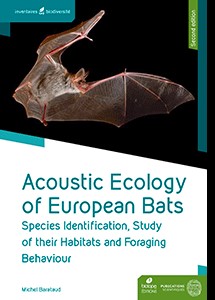Acoustic Ecology of European Bats
Species Identification, Study of their Habitats and Foraging Behaviour
Michel Barataud
Yves Tupinier
Herman Limpens
Anya Cockle-Betian
Preface by Hans-Ulrich Schnitzler12
Preface by Ingemar Ahlén14
Acknowledgments16
Foreword22
List of species25
Glossary26
List of abbreviations35
Chapter 1 The biological sonar37
Background38
Introduction38
Historical background38
General principles of acoustic localization40
Basic concepts in acoustics42
The nature of sound42
Sound waves and their characteristics42
Sound propagation43
Simple sounds and complex sounds44
Sound analysis45
Sound functions46
Emission and reception48
Emission48
Reception48
Sonar signals and social calls49
Chapter 2 Ultrasound detectors53
Technical features of ultrasound detectors54
The microphone54
The treatment of perceived ultrasounds56
Ultrasound decoding systems58
Frequency division or zero-crossing58
Heterodyning60
Time expansion61
Computer-assisted analysis63
Which bat detector for which purspose ?66
Hand-held detectors66
Pure heterodyne detectors
66
Frequency division detectors
67
Detectors with time expansion option
67
Automatic recording tools for passive monitoring67
Time expansion and high-frequency recording systems
68
Frequency division systems
68
Matching technical features to research needs68
Qualitative inventories (speicies lists)
68
Quantitative surveys (activity assessments, habitat studies)
70
Qualitative and quantitatives surveys
70
Sonar signal research
71
Chapter 3 The sonar signals of bats : classification and interpretation73
Method of auditory analysis74
Methodological principale74
The identification process75
Auditory training75
Method of computer-based sound analysis77
Using BatSound77
Reading the different types of graphical display82
The spectrogram : representation of the structure
83
The oscillogram : representation of the envelope
84
The power spectrum : representation of the distribution of energy over frequencies
85
Interpreting signal structure types86
The steep FM structure
86
The QCF structure
86
The flat-ended FM structure (FM-QCF)
90
The CF structure (FMa-CF-FMd) or 'Doppler technology
91
Harmonics
92
Methodology for the measurement of signals94
General measurements
94
Measuring an FM signal
96
Measuring a QCF type signal (BW < 5 kHz)
98
Measuring FM-QCF and flat-ended FM signals
101
Measuring FMa-CF-FMd signals
103
Chapter 4 The acoustic identification of bats107
Method and equipment108
Auditory identification with the heterodyne system111
Criteria for species identification112
Frequency at maximum energy (FME)
112
Structure
112
Rhythm
115
Intensity
117
Possible confusions117
Identification of long CF signals (FM/CF/FM signals of Rhinolophids)118
Identificcation of QCF and flat-ended FM signals119
Bats emitting QCF and flat-ended FM signals of short to intermediate duration with FME>30 kHz
120
Identification of steep FM sweeps131
Identification by means of social calls133
Simplified identification key in heterodyne detection134
Auditory and computer-assisted identification in time expansion135
Criteria for species Identification137
Structure
137
Bandwidth
141
Duration
142
Timbre
143
Frequency band position in the general spectrum (overall pitch of the signal)
144
Energy distribution
145
Rhythm
150
Reading scatter diagrams
151
Identification fo CF signals (horseshoe bats)155
Identification of QCF-FMd signals158
Identification of QCF, FM-QCF and flat-ended FM signals161
Species With FME < 30 kHz
162
QCF signals164
The case of QCF signals below 20 kHz166
QCF and flat-ended FM signals with alternating FMEs167
FM-QCF, flat-ended FM and narrowband FM signal's169
Sequences of QCF, FM-QCF and flat-ended FM signals with FME < 30 kHz171
Species with FME > 30 kHz
176
QCF signals181
FM-QCF, flat-ended FM and narrowband FM signals182
Sequences of QCF, FM-QCF and flat-ended signals with FME > 30 kHz189
Identification of FM sweeps192
The nasal timbre
196
Differentiating genus Barbastella from genus Plecotus196
Distinguishing among the Plecotus species197
Sequences of nasal FM signals199
The whistled timbre
202
Distinguishing true FM species from FM-QCF species202
A special case : the alternating signals of Barbastella barbastellus205
FME < 35 kHz207
FME > 35 kHz (genus Myotis)209
Identification through social calls254
Genus Myotis255
Genus Pipistrellus255
Genera Hypsugo and Vespertilio261
Genus Nyctalus262
Genus Plecotus263
General identification key264
Chapter 5 Applications267
Locating bat roosts268
Introduction and objectives268
Preconditions268
Preparation268
Survey of hunting sites269
Survey of flight routes269
Survey of roost sites269
Survey of mating territories271
The survey in practice272
Population monitoring274
Habitat studies278
Are bat detectors objective tools for assessing the biological value of habitats ?278
Spatio-temporal variability bias280
Sites and count points280
Unit of measurement for bat activity282
Identification285
Species detectability286
Types of activity : foraging, transit and social interactions287
Activity indices287
Acoustic surveys291
Continuous count transects and point counts293
Duration and repeating of point counts294
Descriptor variables of the habitats295
Continuous recording method296
Chapter 6 Acoustic ecology309
The concept of acoustic ecology310
Example 1 : the sonar of the barbastelle312
Description of the alternating signals of Barbastella barbastellus312
Context of emission of alternating signals314
Comparing the alternating signals of Barbastella barbastellus and Nyctalus noctula314
Hypothesis of a relationship between alternated sonar pattern and diet in Barbastella barbastellus315
Example 2 : the sonar of the greater noctule318
Audiograms of passerine birds that migrate by night319
Predation pressure320
Counter-strategy of the predator321
Promising fields for future research326
The sudden irruption of Nyctalus leisleri sequences326
The signals of long-eared bats326
The erratic variations in intensity of Miniopterus schreibersii328
The inter-individual variabililty of signal frequency in horseshoe bats329
Convex versus concave signal structure329
The function of the final whack : strong specialization of Myotis nattereri ?330
Chapter 7 Frequently asked questions on acoustic detection
Frequently asked questions on acoustic detection and identification333
The heterodyne system334
Time expansion336
Scatter diagrams338
Bat activity studies340
Chapter 8 Perspectives343
Technical developments344
Methodological developments344
Extending the method worldwide345
Dissemination of knowledge and skill345
Appendices349
Bibliography350
Scatter diagrams for the identification of the sonar signals of the three Plecotus species studied354
Index360
Downloables files362

